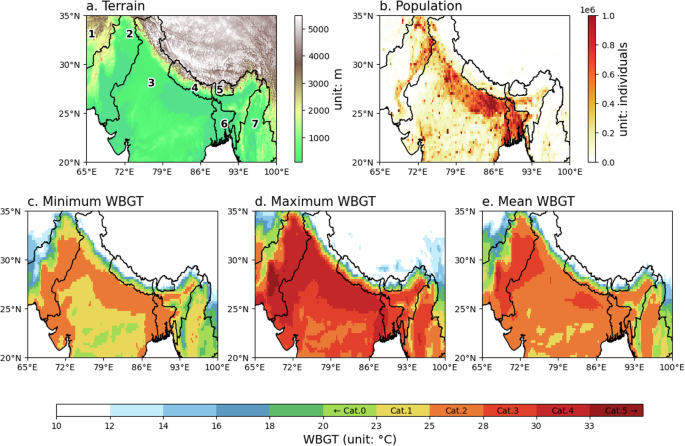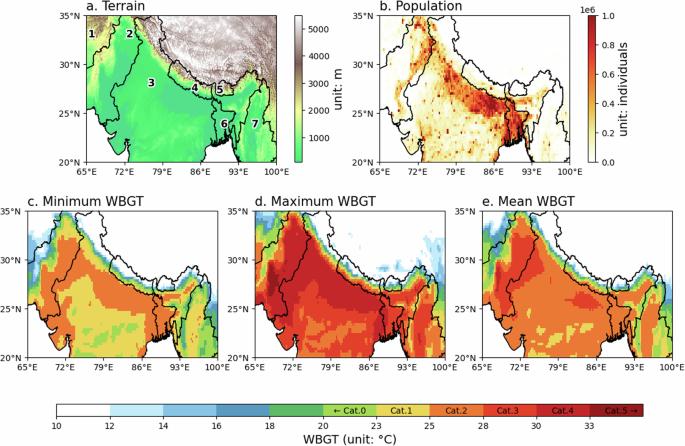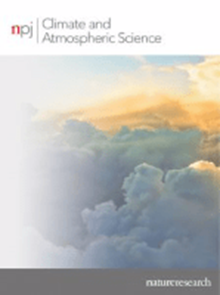评估喜马拉雅山南部在当前和未来气候条件下的热应力和职业风险
IF 8.5
1区 地球科学
Q1 METEOROLOGY & ATMOSPHERIC SCIENCES
引用次数: 0
摘要
喜马拉雅山南部人口稠密,夏季炎热潮湿,面临着世界上最严重的热应力风险。本研究利用每小时 ERA5 数据集(1979-2022 年)和 CMIP6 预测数据集(2005-2100 年),根据湿球温度 (WBGT) 评估过去和未来的热应力。这对喜马拉雅山南部的职业工作量管理具有重要意义。根据 WBGT 临界区间 23 °C、25 °C、28 °C、30 °C 和 33 °C,将热应激水平分为 6 级(0 至 5 级)。由于几乎有一半的时间热压力超过 3 级,人们不得不从事低于中等强度的工作,以确保健康不受影响。本研究采用流动模拟算法,从历史和未来的角度分析了 2020 年夏季前所未有的热压力情况以及相关的大气环流模式。结果显示,2020 年有 80% 以上的时间热应激水平处于 3 级和 4 级。确定的环流模式解释了 27.6% 的极端强度,而在确定的模式下,21 世纪前的气候条件几乎不可能出现这样的极端情况。SSP2-4.5 和 SSP5-8.5 情景下的未来预测表明,与 2020 年类似的热应力将可能成为喜马拉雅山南部的常见现象。在类似的环流模式下,到 21 世纪末,该地区 70% 以上地区的热应激水平将比气候基线至少升高一个等级,导致每天新增 1.205 亿(4.201 亿)人口暴露在 SSP2-4.5 (SSP5-8.5)情景下的最高热应激水平下。本文章由计算机程序翻译,如有差异,请以英文原文为准。


Evaluating heat stress and occupational risks in the Southern Himalayas under current and future climates
The southern Himalayas, characterized by its dense population and hot, humid summers, are confronted with some of the world’s most severe heat stress risks. This study uses the hourly ERA5 dataset (1979–2022) and CMIP6 projections (2005–2100) to evaluate past and future heat stress based on the Wet Bulb Globe Temperature (WBGT). This has significant implications for the management of occupational workloads in the southern Himalayas. Heat stress levels are classified into 6 categories (0 to 5) using WBGT threshold intervals of 23 °C, 25 °C, 28 °C, 30 °C, and 33 °C. With heat stress surpassing level 3 for almost half of the time, people are constrained to engage in less than moderate workloads to ensure their health remains uncompromised. Flow-analogous algorithm is employed to contextualize the unprecedented heat stress case in the summer of 2020 and the associated atmospheric circulation patterns from historical and future perspectives. The results show that over 80% of the time in 2020, heat stress levels were at 3 and 4. The identified circulation pattern explains 27.6% of the extreme intensity, and such an extreme would have been nearly impossible in pre-21st-century climate conditions under the identified pattern. Future projections under SSP2-4.5 and SSP5-8.5 scenarios indicate that heat stress similar to what was experienced in 2020 will likely become a common occurrence across the southern Himalayas. Under a similar circulation pattern, the heat stress levels by the end of the 21st century would be elevated by at least one category compared to the climatic baseline in over 70% of the region, leading to an additional 120.5 (420.1) million daily population exposed to the highest heat stress level under the SSP2-4.5 (SSP5-8.5) scenario.
求助全文
通过发布文献求助,成功后即可免费获取论文全文。
去求助
来源期刊

npj Climate and Atmospheric Science
Earth and Planetary Sciences-Atmospheric Science
CiteScore
8.80
自引率
3.30%
发文量
87
审稿时长
21 weeks
期刊介绍:
npj Climate and Atmospheric Science is an open-access journal encompassing the relevant physical, chemical, and biological aspects of atmospheric and climate science. The journal places particular emphasis on regional studies that unveil new insights into specific localities, including examinations of local atmospheric composition, such as aerosols.
The range of topics covered by the journal includes climate dynamics, climate variability, weather and climate prediction, climate change, ocean dynamics, weather extremes, air pollution, atmospheric chemistry (including aerosols), the hydrological cycle, and atmosphere–ocean and atmosphere–land interactions. The journal welcomes studies employing a diverse array of methods, including numerical and statistical modeling, the development and application of in situ observational techniques, remote sensing, and the development or evaluation of new reanalyses.
 求助内容:
求助内容: 应助结果提醒方式:
应助结果提醒方式:


